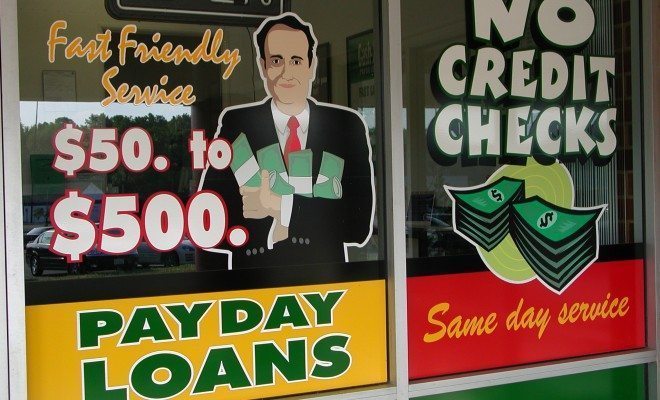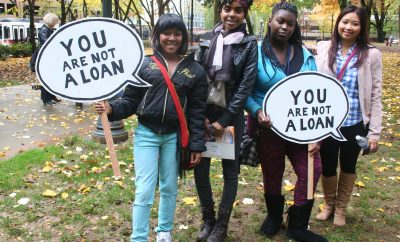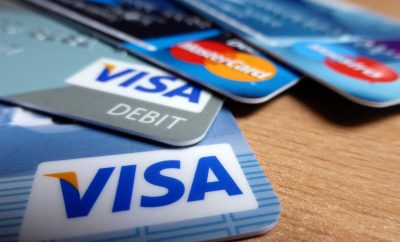 "Payday Loan Place Window Graphics" courtesy of [Taber Andrew Bain via Flickr]
"Payday Loan Place Window Graphics" courtesy of [Taber Andrew Bain via Flickr]
Business & Economics
Payday Loans: Predatory or Necessary?
Access to credit is a necessity for individuals who are faced with a sudden financial emergency. But for the “unbanked” and “underbanked,” there are very few options to get that access. To cover an unexpected expense, even a relatively modest one, that they can’t pay for with their savings or by selling something, these individuals often turn to payday loan providers. It’s an industry that generates billions of dollars a year and is characterized by many as being unconscionable. The interest rates on the loans are often as high as 400 percent per year (though the loans typically last two weeks) and users of payday loans are often trapped in a cycle of loan renewals that result in paying thousands of dollars to borrow hundreds.
High Interest Rates
The terms of payday loans are terms that most of us would never consider signing on for. An interest rate of 400 percent is by any definition, usury. But for the unbanked and the underbanked who desperately need that credit to get them through whatever emergency they are facing, those terms are agreed to. Contracts like this are sometimes referred to as “contracts of adhesion.” A contract of adhesion is one that involves a stark difference in the power of the two parties–where the stronger party is the drafter and the weaker party is unable to modify or negotiate the contract. Usually, these contracts are found in large transactions, like purchasing a house or a car. Courts are willing to take a closer look at these contracts because of the differences in bargaining power and if they find the contract, or a provision of it, to be “unconscionable” they will invalidate it.
The court’s ability to invalidate these contracts is meant to protect the weaker parties with little bargaining power. Just as stricter regulations on payday loan providers would be an attempt to protect the unbanked and underbanked from “predatory” lending practices. But calls for regulation do not address the underlying concern that if the payday loan industry were eliminated and nothing replaced it the unbanked and underbanked might actually be worse off than they were before. They would have no access to emergency credit. And while the majority of people who use payday loans get caught in a trap of debt some people are able to use these loans and benefit from them. If payday loans are going to be regulated to extinction or outright eliminated there needs to be some instrument for emergency credit to replace them.
By The Numbers: How Do PayDay Loans Work?
So what exactly are the terms of a payday loan? How bad are they really? Pretty bad, as it turns out. They are designed to not be paid back, which is why some states have banned them altogether. But that is, from the lenders’ point of view, the beauty of the system. Here is how it works. The borrower takes out a loan to pay off a debt. Often that debt is fairly small–the typical payday loan is for a few hundred dollars–and the term of the loan is usually two weeks. Borrowers often can’t pay back their loan within that two week period, which is not surprising given that they had no savings to fall back on, causing them to take out the loan in the first place. Borrowers then often end up “renewing” the loan. This is where loan providers make much of their money, from the frequent renewals. More than 80 percent of payday loans are renewed at least once and 22 percent are renewed six times or more, ultimately costing borrowers more in fees than the amount they borrowed in the first place.
Let’s use some of the numbers from Mehrsa Baradaran’s book “How The Other Half Banks” as an example. If someone takes out a loan of $325, a typical amount, and renewed it eight times (or took four months to pay it off) would cost the borrower $793. That number reflects a principal of $325 combined with additional interest of $468. In a very short time, the interest added up to almost 1.5 times the initial loan.
It actually gets worse. When the borrowers take out payday loans they sign over their paychecks or give a lender permission to withdraw money directly from their account. So when they get their paychecks the money they owe is taken directly from them, taking, according to a report from Pew Charitable Trusts, 36 percent of the borrower’s paycheck before they even get their hands on it to pay for other expenses–automatically.
Take a listen to this for an audio recap of how some of these numbers work out.
Given how high these interest rates are, what kind of borrowers would agree to them? It may not be the individuals you think. It isn’t the completely destitute who take out payday loans because they can’t offer their future paychecks to pay the loans back. According to a survey conducted by the Pew Charitable Trusts, “there are five groups that have higher odds of having used a payday loan: home renters, those earning below $40,000 annually, those without a four-year college degree, those who are separated or divorced, and African Americans.”
This PBS segment on the issue does an excellent job of showing the kinds of individuals who might take out a payday loan and some of the effects that it has on them and on society as a whole.
Unconscionability And Solutions
The numbers for the unconscionability argument against payday loans certainly seem damning at first glance. But just because the fees are high does not mean that they are unfair from an economic perspective. According to the economists at Liberty Street Economics, the unfairness argument shouldn’t necessarily depend on what the fees are but rather on whether those fees are being determined by a competitive market. A competitive market will produce a fee that is “fair,” but will still allow companies to cover the costs of doing business. One could make the argument that the costs of running this business are so high because these debtors are bad credit risks (likely to default) so higher fees are justified to cover the costs of those defaults. Providing credit isn’t a charity and we shouldn’t be writing policy as though it were.
Payday lenders will point to the high default rate on payday loans, and therefore the increased risk to the lender, as an explanation for high interest rates. If you look at the default rate for payday loans they are pretty high–studies in different states have found default rates of between 44 and 56 percent. This is not surprising when you are lending to a segment of the population that has no savings and limited access to banking options.
But the rate of default is more complicated for payday lenders. Payday lenders have the unusual and critical advantage of being able to draw funds directly from the borrower’s account. This means that while the borrower may “default” because they don’t have enough money to pay back their debt in their account the lender can take the money anyway and subject the borrower to an overdraft penalty on their account. So the lender is still getting repaid even though they are categorizing it as a default. The Center for Responsible Lending calls this “Invisible Default.” In fact most borrowers (66 percent) who “default” actually do end up paying their debt back. The default rates on payday loans is often used to explain why lenders charge such high interest rates, but if lenders are still able to recover most or all of the money, these invisible defaults may not be as financial damaging as it may seem.
Potential Alternatives
There are several potential ways to reform payday loans but the two main ways, other than eliminating them altogether, are capping the amount of interest that can be charged and putting a cap on the number of times the loan can be renewed. A 36 percent cap is what is often proposed, but that is effectively viewed as a ban on payday lending, as lenders claim that they would not be able to cover costs. Even though 36 percent is much higher than the average credit card interest rate, the loan amounts are so small and the risk of default is so high that it probably would kill off payday lending, at least as it currently operates. A cap on renewals would also be costly for them but perhaps not to the same extent, depending on how many renewals were allowed per loan. If the number was very high it might not present much of a deterrent to either lenders or borrowers.
It is possible for a borrower to use a payday loan and not become ensnared in debt, as long as that borrower is able to avoid renewing that debt repeatedly. For those borrowers who need that credit and who believe they will be able to pay it back in two weeks, it seems unfair to eliminate their ability to borrow money at all. The inability of other people to borrow responsibly shouldn’t hinder their ability to enter into contracts that they think will benefit them, even if they end up being wrong.
The main premise for nullifying a contract of adhesion is that the parties weren’t on equal terms, and often, it is based on the notion that if the weaker party really knew what they were signing up for they wouldn’t have done so. But in the case of payday loans, the borrowers do understand that they are signing a contract that is skewed entirely in the lender’s favor–the evidence suggests that they know what they getting into and are choosing to sign up for it anyway. Eliminating payday lenders without presenting another option is taking away their ability to make financial choices and preventing them from accessing credit.
The answer to an individual contract of adhesion may be to nullify the contract if there really is evidence of foul play and manipulation. But the answer to millions of those contracts isn’t to assume that each one was made by predators and prey. It’s to come up with a better kind of contract; one in which the terms are not seen as unconscionable by outside parties.
Borrowers are always going to need access to credit. Payday loans, as awful as they are, exist because that need is not being met by any other lender. But it could be–there are several different solutions to the problem of credit for the unbanked and the underbanked that we could implement here in order to eliminate the majority of the demand for payday loans. One such solution is one advocated in the book “How The Other Half Banks,” which is the institution (or actually re-institution) of the U.S. Post Office as a banking service. If you would rather listen to a discussion of the idea, you can listen to Mehrsa Baradaran, the book’s author, talk about it here. As discussed in both the podcast and the book, post offices reach even very remote communities and could be used as a place to deposit funds and could even be used to provide emergency credit.
Another solution Barandaran discusses is a British style overdraft where you are allowed to have a negative balance on your checking account (for an interest fee) without paying the high overdraft fees that many banks currently charge. If there were other options for borrowers who utilize payday loans to access the credit they need, such loans may not be necessary.
Conclusion
Payday loans can be a spectacularly bad idea for borrowers, especially if they are not able to pay off their balance after the loan’s two-week period. The problem is that for the people who need them, a spectacularly bad idea may still be better than the alternative. The solution to the problem is not to eliminate a service, that despite its flaws may still be necessary, without replacing it. Rather a better solution for borrowers is to create an option, or a combination of several options, that gives them access to credit.
Resources
Goodreads: How The Other Half Banks
Pew Charitable Trusts: Payday Loan Facts and the CFPB’s Inpact
Liberty Street Economics: Reframing The Debate About PayDay Lending
International Business Times: Payday Loans: Study Highlights Default Rates, Overdrafts As Groups Debate CFPB Regulations
Cornell Law School: Contract of Adhesion
SlateMoney: PayDay Loans, Postal Banking and Pre-paid Credit Cards
Huffington Post: PayDay Loans: The Worst Abuse is not Regulated
The Center for Responsible Lending: Payday Mayday: Visible and Invisible Payday Lending Defaults








Comments